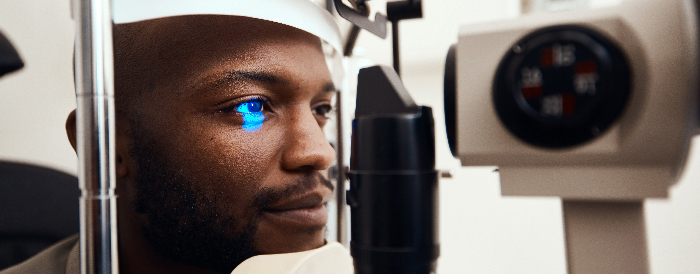KEEP AN EYE ON YOUR EYE HEALTH

Understanding these common eye conditions and how to manage them can help you keep your eyes healthy as you age and maintain good vision longer.
Chronic Dry Eye
Chronic dry eye, often linked to inadequate tear production or function, can lead to discomfort and, in some cases, vision issues. It affects millions of Americans but can be managed to maintain eye health and comfort.
Symptoms: Symptoms include burning, dryness, itching, blurry vision, and redness.
Risk: The risk of getting dry eye is higher for people who are aged 50 or older, female, or wear contact lenses. Risk is also heightened by deficiencies in vitamin A or omega-3 fatty acids, and among people with certain autoimmune conditions, like lupus.
Prevention: To alleviate dry eye discomfort:
- Avoid direct air exposure, use humidifiers, and wear protective eyewear.
- Take breaks during prolonged tasks that require visual concentration.
- Position your computer screen below eye level.
- Quit smoking and avoid second-hand smoke.
- Regularly use artificial tears, even when symptoms are absent, to maintain eye lubrication.
Diabetic Retinopathy
Diabetic retinopathy, which affects people with diabetes, can cause vision loss and blindness. At first, symptoms may go unnoticed, so regular eye exams are crucial for early detection and treatment.
Symptoms: Early stages are often symptom-free, but as diabetic retinopathy advances, it can lead to blurry vision, floaters, and potential blindness.
Risk: Anyone with any form of diabetes can get diabetic retinopathy, and the risk increases the longer you have diabetes. People with diabetes who are pregnant or who develop gestational diabetes are at a higher risk and should get frequent eye exams.
Prevention: Managing diabetes through blood sugar control, exercise, and a healthy diet is the best way to reduce your risk of diabetic retinopathy. In addition, consider:
- Getting regular A1C tests to help set and achieve blood sugar goals.
- Controlling blood pressure and cholesterol levels to further lower the risk of vision loss.
- Prioritizing regular eye exams, as early detection is crucial, especially when symptoms may not be present.
Age-Related Macular Degeneration (AMD)
Age-Related Macular Degeneration (AMD) is a common eye disease that can blur your central vision. It occurs when aging gradually causes damage to the macula. While AMD doesn’t cause total blindness, it does blur straight-ahead vision. Early detection and lifestyle choices are crucial in managing AMD.
Symptoms: Early AMD often lacks noticeable symptoms, while late-stage AMD may cause wavy or distorted central vision.
Risk: The risk for AMD increases with age – people aged 55 and older are at higher risk. The risk for AMD is also higher for people who have a family history of AMD, are Caucasian, and smoke.
Prevention: To mitigate AMD risk and slow its progression, consider these steps:
- Quit smoking and avoid second-hand smoke.
- Engage in regular physical activity.
- Maintain healthy blood pressure and cholesterol levels.
- Consume a diet rich in leafy greens and fish.
- Schedule regular eye exams for early detection and proactive management.
Source: nei.nih.gov
